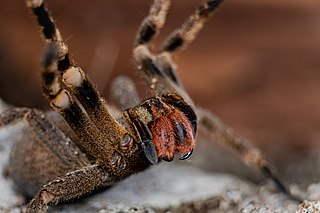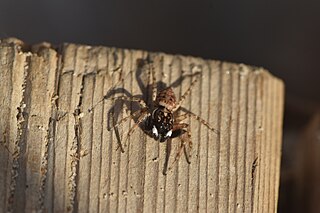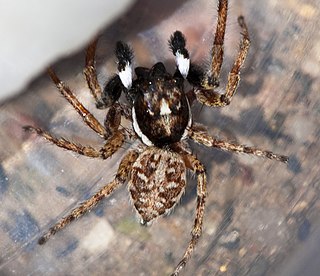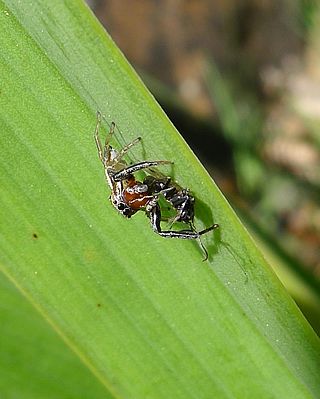
Phoneutria is a genus of spiders in the family Ctenidae. They are mainly found in northern South America, with one species in Central America. Members of the genus are commonly referred to as Brazilian wandering spiders. Other English names include armed spiders and banana spiders.

Wandering spiders (Ctenidae) are a family of spiders that includes the Brazilian wandering spiders. These spiders have a distinctive longitudinal groove on the top-rear of their oval carapace similar to those of the Amaurobiidae. They are highly defensive and venomous nocturnal hunters. Wandering spiders are known to hunt large prey, for example hylid species Dendropsophus branneri. Despite their notoriety for being dangerous, only a few members of Phoneutria have venom known to be hazardous to humans, but the venoms of this family are poorly known, so all larger ctenids should be treated with caution.
Capeta is a genus of spiders in the family Salticidae.

Phoneutria boliviensis is a species of a medically important spider in the family Ctenidae found in Central and South America.

Phoneutria fera is a species of spider with medically significant venom in the family Ctenidae found in South America. It is commonly known as the Brazilian wandering spider and the banana spider, although these names are applied to other species in the genus Phoneutria, particularly Phoneutria nigriventer. P. fera tends to spend a larger amount of time in vegetation during the early period of its life and spends more time on the ground once it becomes larger. This is more common in females, since they are usually larger than males. Medical records from within the geographic range of P. fera show bites, have the potential to develop moderate to severe systematic reactions in humans.

Phoneutria nigriventer is a species of medically significant spider in the family Ctenidae, found in the Southern Cone of South America. Along with other members of the genus, they are often referred to as Brazilian wandering spiders.
Phoneutria reidyi is a species of venomous spiders in the family Ctenidae, found in South America.

Unicorn ("one horn", in Latin) is a genus of goblin spiders from South America, containing seven species that occur predominantly in high elevation, semi-desert regions of Bolivia, Chile, and Argentina. Individuals are relatively large for goblin spiders, measuring up to 3.0 mm (0.12 in) in body length. The genus name refers to a characteristic pointed projection between the eyes and jaws of males. In at least one species, broken-off tips of the male pedipalps have been found within the genitalia of females, postulated as a means of sperm competition. Unicorn possesses several traits that suggest it is a relatively "primitive" member of the Oonopidae, and is classified with other similar, soft-bodied goblin spiders in the subfamily Sulsulinae.
Phoneutria pertyi is a species of spiders in the family Ctenidae, found in Brazil.
This glossary describes the terms used in formal descriptions of spiders; where applicable these terms are used in describing other arachnids.

Menemerus meridionalis is a species of jumping spider in the genus Menemerus that lives in South Africa. The species was first described in 1999 by Wanda Wesołowska, one of over 500 descriptions she produced during her lifetime. The spider is small, with a carapace that is typically 2.8 millimetres (0.11 in) long and an abdomen 3.3 millimetres (0.13 in) long. The carapace is generally dark brown with a white stripe down the middle while the abdomen has a dark brown stripe. Otherwise, it is its copulatory organs that most distinguish the species from others in the genus. The male has a lumpy retrolateral tibial apophysis, similar to but smaller than Menemerus tropicus, and a very small spiked ventral tibial apophysis.

Menemerus pulcher is a species of jumping spider in the genus Menemerus that lives in Mauretania. The species was first described in 1999 by Wanda Wesołowska. The spider is small and brown, with an atypically high carapace that is 2.6 millimetres (0.10 in) long and an abdomen 2.8 millimetres (0.11 in) long. There is a white stripe running down the back of the otherwise brown carapace. The abdomen is yellowish-fawn with a dark pattern that is reminiscent of a fleur-de-lis and more rounded than other spiders in the genus. Otherwise, it is externally similar to Menemerus plenus, although it can be distinguished by its copulatory organs. The male has a double embolus and two large parallel retrolateral apophyses, or appendages. The female has not been described.

Evarcha bakorensis is a species of jumping spider in the genus Evarcha that lives in Guinea, Ivory Coast and Nigeria. It thrives in savanna grasslands. The species was first described in 2002 by Christine Rollard and Wanda Wesołowska. The spider is small, with a cephalothorax measuring between 1.6 and 1.8 mm long and an abdomen that is between 1.3 and 1.9 mm long. The female is larger than the male. The cephalothorax has a light brown topside, or carapace, yellow underside, or sternum, and darker sides. The abdomen is greyish-brown or brown and has a lighter pattern on it. The spider has generally brown legs. It has distinctive copulatory organs. The female has a large membrane in the centre of its epigyne while the male has a straight and blunt tibial apophysis, or projection on its palpal tibia.
Thiratoscirtus gambari is a species of jumping spider in the genus Thiratoscirtus that lives in the forests of Nigeria. The species was first described in 2011 by Wanda Wesołowska and Russell-Smith. Female examples included at the time were later discovered to have been misidentified and so only a description of the male is available. It is a medium-sized spider, with a wider cephalothorax that is typically between 3.4 and 4.7 mm long and an abdomen that is 3.2 and 4.5 mm in length, both oval in shape. It is generally dark brown and grey on top and brownish-orange underneath, although some examples have a lighter underside to their abdomen, and has yellow to brown legs with brown hairs and spines. Its fang is unusual in having small angular features near its base. The spider also has distinctive copulatory organs that enable it to be distinguished from other members of the genus, particularly the relatively wide club-like tibial apophysis, or protrusion on its palpal tibia, and the wing-like appendages on its cymbium.

Menemerus tropicus is a species of jumping spider in the genus Menemerus that lives in Kenya and Uganda near Lake Victoria. The spider lives in large nest complexes that can stretch between trees in mangrove savannas. The species was first described in 2007 by Wanda Wesołowska, one of over 500 descriptions she has written during her lifetime. It is a small spider, with a flattened cephalothorax that is between 1.7 and 2.1 mm and a rounded abdomen between 1.7 and 2.9 mm long. The female is larger than the male and has a darker abdomen and lighter carapace. The male abdomen has a pattern that includes a brown streak and silver spots. The female has a yellowish streak, in some examples, with yellow patches. The legs are brown and yellow. The copulatory organs help distinguish the species from others in the genus. The male has a very short double embolus and very large retrolateral apophysis. The female has a narrower pocket in its epigyne, narrow insemination ducts and small spherical spermathecae.
Afrobeata firma is a species of jumping spider in the genus Afrobeata that lives in Yemen. The species was first described in 1994 by Wanda Wesołowska and Antonius van Harten. The spider has a carapace measuring between 2.9 and 3.6 mm long and an abdomen between 2.9 and 4.2 mm long. It is generally dark brown, although the underside is lighter. The male has a pattern of chevrons and spots on its abdomen. The female has shiny scales. The male also has distinctively-shaped teeth to the rear of the chelicerae while the female has a single bicuspid tooth. The front legs of the male are longer than the rest. The female copulatory organs are similar to the related Afrobeata latithorax but the seminal ducts are distinctive. They are complex and coiled, surrounding the heavily sclerotized spermathecae. The male has a small tooth-like appendage on its palpal tibia, or tibial apophysis, and a very long thin embolus that circles the round palpal bulb.

Asemonea amatola is a species of jumping spider in the genus Asemonea that is endemic to South Africa. It lives in trees in mountain ranges. The spider was first defined in 2013 by Wanda Wesołowska and Charles Haddad. The spider is small, with a white or whitish-yellow pear-shaped carapace between 2.0 and 2.6 mm long and an abdomen between 2.4 and 2.8 mm long that has a pattern of dark dots on an otherwise light surface. The copulatory organs are distinctive. The female has spines on its pedipalps and a large epigyne with two large shallow depressions. The male is larger than the female and has a distinctive pedipalp with a three-armed apophysis on the femur and three apophyses on the tibia.
Ctenus captiosus, known generally as the Florida false wolf spider or tropical wolf spider, is a species of wandering spider in the family Ctenidae. It is found in the United States., and is one of two species of Ctenidae occurring in Florida. Little is known about the biology of this species.

Loxosceles intermedia, the Brazilian brown recluse spider, is a highly venomous spider species in the family Sicariidae native to Brazil and Argentina.
Phoneutria depilata is a species of spider in the family Ctenidae, found in Central America.











